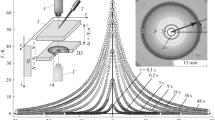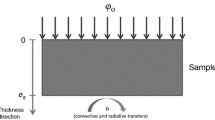Abstract
This paper presents a new way to reduce data in the laser flash method of measuring thermal diffusivity. Experimental temperature vs time data are first transformed by using the Laplace transformation, and then they are fitted with an appropriate theoretical formula. The data reduction procedure is more efficient and enables the use of more realistic models of heat conduction in the sample, because the theoretical formulae for transformed temperatures have a simpler form than those for nontransformed ones. Some examples of the theoretical formulae of transformed temperatures are included here for one- and two-dimensional heat transfer, respectively. The models described take into account a finite pulse time and heat losses from the sample. Two fitting algorithms are proposed. Experimentally, the data reduction procedure has been tested for a correction of the finite pulse time effect in the flash method. The results show that the accuracy of our procedure is comparable with other data reduction methods. Provided that the shape and duration of the pulse are known, this procedure allows elimination of the finite pulse time effect on calculation of the thermal diffusivity for any transformable heat pulse time function, even in cases where the other specialized data reduction procedures have failed.
Similar content being viewed by others
References
W. J. Parker, R. J. Jenkins, C. P. Butler, and G. L. Abbott, J. Appl. Phys. 32:1679 (1961).
Y. Iida, T. Takashima, and H. Shigeta, Proceedings of the 2nd Japan Symposium on Thermophysical Properties (1981), p. 1 (abstract in English).
Y. Iida, H. Ohura, and T. Muraoka, Proceedings of the 6th Japan Symposium on Thermophysical Properties (1985), p. 85 (abstract in English).
Y. Iida and M. Kikuchi, Proceedings of the 9th Japan Symposium on Thermophysical Properties (1988), p. 25 (abstract in English).
Ph. Delpech, D. Boscher, A. Deom, and D. Balageas, Actes du Colloque de Thermique PROGRES et DEFIS ACTUELS, Vol. 2, ISITEM, Nantes, 16–17 May 1990 (SFT and ISITEM, Nantes, 1990), p. 177 (in French).
H. S. Carslaw and J. C. Jaeger, Conduction of Heat in Solids, 2nd ed. (Oxford University Press, Oxford, 1959), p. 298.
K. B. Larson and K. Koyama, J. Appl. Phys. 38:465 (1967).
K. B. Larson and K. Koyama, J. Appl. Phys. 39:4408 (1968).
L. I. Turchak, Basics of Numerical Methods (NAUKA, Moscow, 1987), p. 99 (in Russian).
J. Gembarovič, L. Vozár, and V. Majerník, Int. J. Heat Mass Transfer 33:1563 (1990).
T. Azumi and Y. Takahashi, Rev. Sci. Instrum. 52:1411 (1981).
R. E. Taylor and L. M. Clark III, High Temp. High Press. 6:65 (1974).
Author information
Authors and Affiliations
Rights and permissions
About this article
Cite this article
Gembarovic, J., Taylor, R.E. Use of the Laplace transformation for data reduction in the flash method of measuring thermal diffusivity. Int J Thermophys 14, 297–311 (1993). https://doi.org/10.1007/BF00507815
Received:
Issue Date:
DOI: https://doi.org/10.1007/BF00507815




